Author Benjamin Wood seems to find his stories among the desperately brilliant and talented, who can’t seem to get a handle on their own intelligence. In The Bellwether Revivals, his characters get themselves into trouble because Cambridge somehow isn’t intellectually stimulating enough. Wood’s characters are continually grappling with the anxiety of influence, paralyzing themselves entirely.
In his newest novel, the characters are an overwhelmed group of artists who have fled to a secretive colony on an island near Turkey. Here, they have all their needs taken care of and they are to focus only on their work. Novelists, playwrights, painters and the like are sponsored by a previous tenant who has since become successful.
The tale is seen through the eyes of Knell (not her real name — everyone has a pseudonym), a celebrated painter in London who has lost her drive. The cabal of four frustrated geniuses has been there the longest and have forged a bizarre friendship. Under the watchful eye of the provost, the inhabitants are expected to respect each other’s anonymity and not make contact with the outside world.

With occasional flashbacks to earlier years as an unknown artist and then a very sought-after one, the majority of the books follows Knell as she is finally forced to confront her hang-ups when one of the new artists is found dead.
Wood has an uncanny ability in describing very surreal and abstract concepts. The obscure works of these artists are so life-like that I wish I could view them in real life. And yet, they remain strange and unknowable. The characters should be perceived as selfish and arrogant — and they are — but they are also sympathetic. There is far more to their inability to create than lack of motivation.
Knell begins creating her own paints using bioluminescent fungi that she has found growing in the forest. She gathers, dries and grinds the glowing mushrooms into a dust that becomes the pigment for paint.
A spume of blue rushed from the punctured plastic, as though I had unearthed some underground lagoon. It is not take me long to garland them — eight strings of fungus in total, densely packed — and I hung them from the crossbar of my closet to dry out. I retrieved the one remaining garland from the depths of where I had hidden it; its glow was that bit fainter than the rest, but it yielded plenty in the mortar when I ground it down. Loading all the powder on the slab, I went to consult my samples, checking the dosages of the old and fruithead sizes that were noted in the margins of the squares. Choosing the right tone and gleam, I made the measurements, added the linseed oil to the powder, slid the muller over it until I had a good consistency. ~ Pg 388
As with Bellwether, the novel ends with a bang. The rest of the novel has a few too many lulls, in between the major plot points. I could have done without the entire Jim storyline altogether. Knell could have just as well been having anxiety about her work and her gallery agent rented her a seaside cottage. It would have made a much bolder story, and a stronger Knell in the end, I think.
Still, I highly recommend the book for its fresh and unflinching style, and the way Wood makes illustrating art with words seem effortless and ethereal.
And I will let you discover the meaning of ecliptic.
Many thanks to Tessa at Penguin Press for the review copy.
____
Hardcover: 480 pages
Publisher: Penguin Press (May 3, 2016)
Language: English
ISBN-10: 1594206864
ISBN-13: 978-1594206863
Product Dimensions: 6 x 1.2 x 9 inches

